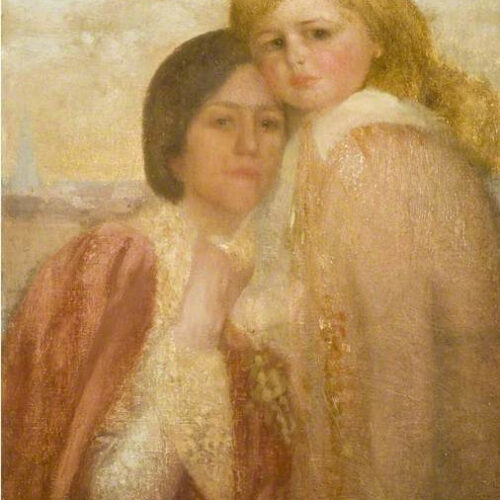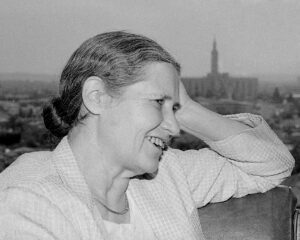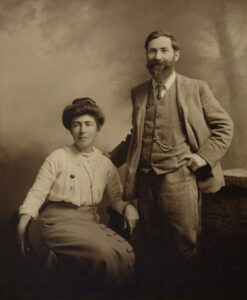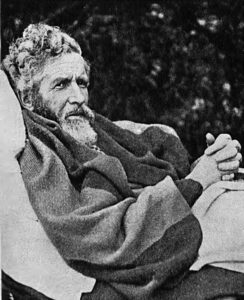

Lift the heart to high endeavour!
Fire the thought and nerve the will!
Though the bonds be hard to sever,
Clasp your faith in justice still!
From ‘Woman’s Song of Freedom’ by Lilian Sauter (1911)
Lilian Sauter was a writer, poet, suffragist, and member of the West London Ethical Society – a prominent group in the early humanist movement. She and her artist husband moved in creative, intellectual circles, far removed from her conformist upbringing. Independent-minded and well-read, she was said to have exerted significant influence on the thinking (and questioning) of those around her, including her brother, John Galsworthy.
A rare spirit in a frail body, it was she who brought to us three younger ones the greater part of such mental stimulus as our very normal, ordinary lives ever knew. Always quietly busy herself with her painting, reading or writing, it was she who would start interesting subjects for discussion; she who told us stories when we were little; she who opened our eyes and minds to beautiful things to be seen or heard or read.
Mabel Edith Reynolds (née Galsworthy) in The Life and Letters of John Galsworthy by H.V. Marrot (1973)
Blanche Lilian Galsworthy was born in 1864 in Marylebone, to John and Blanche Galsworthy. The family later moved, with Blanche’s younger brother John, to Parkfield, a large house on Kingston Hill, Surrey. At that time it was an area of rural calm, close enough to London for their father to commute to his job as a lawyer in London. He accrued significant wealth by buying land and building grand houses in nearby Coombe for his family, and then selling them to wealthy businessmen attracted to the exclusive location. Despite the privilege of her upbringing, Blanche (known as Lilian) was a rebellious and outspoken young woman – a reaction to her controlling and narrow minded mother. She wrote poetry and read widely, which opened her mind to the limitations on women’s lives. Her rebelliousness was crystallised when, aged 30 in 1894, she married the Bavarian painter Johann Georg Sauter, known as Georg. The family disapproved, decrying Georg as an artist, a foreigner, and of peasant stock. Georg was, though, commissioned by her father to paint family portraits, and his subsequent involvement in the family (and his traumatic experiences as a German in England), had a profound effect on all of their lives, especially on that of Lilian’s brother John.

In 1901, Lilian and Georg were living at 1 Holland Park Avenue with their young son Rudolf. Their home became a meeting place for artists, poets, and writers. Lilian was active in the suffrage movement and is recorded as having introduced others to the meetings. She wrote rallying verse for suffragette newsletters, which was performed to music at their meetings. In 1913 she was the temporary Honorary Secretary of the Spiritual Militancy League (for the Women’s Charter of Rights and Liberties) – an initiative born of the West London Ethical Society and led by Adela Coit. Their aim was to seek the support of clerics for a spiritual and moral perspective on women’s place in society, regardless of their views on the vote. The League rejected destructive or violent protest in favour of a silent presence in church pews (where they became known as The Wasps due to their black and yellow attire), in order to demonstrate ‘spiritual militancy’ against the failure to emancipate women. A book of her poems was published under the title Through High Windows in 1911. Three of its poems are on the theme of women’s liberation: ‘Woman’, ‘Woman’s Plea for Suffrage’ and ‘Woman’s Song for Freedom’.
Sauter’s life changed forever when in 1916 her husband was interned in harsh conditions as an enemy alien in the UK and then repatriated to Germany. Her son too, born in Germany, was interned in 1918. Lilian could only make occasional visits to her son and never saw Georg again. Her brother tried to intervene for the release of both men without success. He claimed that Lilian’s poor health and subsequent death in 1924 were due to a broken heart, and the treatment of prisoners and enemy aliens became a passionate and personal cause.
She was a person of extraordinary character and will-power, and of quite outstanding intellectual ability. She had too a gentle and sympathetic nature, and an ability to communicate with those with whom she came into contact.
Catherine Dupré, John Galsworthy: a Biography (1976)
A death notice in the Nottingham Evening Post described Lilian Sauter as ‘a frail little woman whose gentle personality was far reaching in its personal influence.’ Though still too often referred to merely as the sister of the author John Galsworthy or wife of the artist Georg Sauter, her impressive influence is coming to be better appreciated. Sauter was one of many freethinking women who populated and propelled the early humanist movement, and one whose sharp mind and passion for the arts shaped the development of those around her.
Lilian Sauter, Through High Windows (1911)
Helen Carr, The Verse Revolutionaries (2009)
Francesca Wade, Square Haunting (2020)
Alec Fréchet, John Galsworthy: A Reassessment (1982)
James Gindin, John Galsworthy’s Life and Art: An Alien’s Fortress (1987)
Jill F. Durey, ‘Alien Internment in John Galsworthy’s The Bright Side and The Dog it was that Died’ in Literature and History 30 (1) (2021)
Patricia Panizzo and Sue Lown, ‘A Fair and High Locality’: Chronicle of Coombe Ridge House and ‘The Manor of Coombe’ (1996)
By Liz Goodacre

I lost religion in a breath; Heaven fled from me on the wings of Reason… Doris Lessing, Under My Skin: […]

Truth needs the friendly grip of earnest men and women of every class. There is no distinction where it dwells. […]

A distinctively Edwardian rationalist radical, he himself agreed that he was a crank – ‘a small instrument that makes revolutions’. […]

It has been suggested that matter is capable of destruction, that every atom is destined to be dissolved away in […]